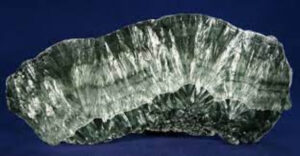Introduction to seraphanite
Seraphanite is a rare silicate mineral with formula: K2Na2Ca4(Si4O10)(OH)2·4H2O. It was first described in 1887 and named for its resemblance to the Seraphim, a type of angel.
The mineral is found in metamorphic rocks associated with albite, biotite, and quartz. It occurs as tabular to prismatic crystals up to 2 cm in length. Seraphanite is colorless, white, or pale pink in color. It has a Mohs hardness of 3 and a specific gravity of 2.6.
Seraphanite is a member of the triclinic crystal system. It is typically found as twinned crystals with a polysynthetic twinning. The mineral is commonly found in the form of rosettes.
The mineral contains the following chemical elements: potassium (K), sodium (Na), calcium (Ca), silicon (Si), oxygen (O), and hydrogen (H).
The history of seraphanite
Seraphanite is a gemstone that was first discovered in the late 1800s. It is a variety of the mineral known as kermesite and is found in a number of locations around the world, including the United States, Mexico, and Russia. The name seraphanite comes from the Greek word for “fiery” or “burning,” which is fitting given its vibrant colors.
The first seraphanite deposits were found in the U.S. state of California in the late 1800s. The stone was named after the nearby Seraphine Mine, where it was first discovered. Seraphanite from this mine is known for its rich green colors.

Discovered in Mexican
In the early 1900s, seraphanite was also discovered in the Mexican state of Sonora. The stone from this area is typically a deep green or blue-green color.
More recently, seraphanite deposits have been found in the Ural Mountains of Russia. The stone from this area is usually a pale green color.
Used in Jewelry
Seraphanite is most commonly used in jewelry, but it can also be used in other decorative applications. The stone is relatively soft, so it is often cut into cabochons or used in beaded designs. It can also be polished to a high shine.
Because of its vibrant colors, seraphanite is a popular gemstone for those who enjoy wearing unique and eye-catching jewelry. It is also a relatively affordable gemstone, which makes it a great option for those on a budget.
The physical properties of seraphanite
Seraphanite is a rare green mineral that was first discovered in Russia in 1851. It is named after the Seraphim Angels, as its color is similar to that of their feathers. The mineral is found in metamorphic rocks, and its main use is as a gemstone.
Seraphanite is a member of the tourmaline group, and its chemical formula is (Na,Ca)_2Al_4Si_6O_18(OH)_4. The mineral is green in color, and its Mohs hardness is 7. It has a vitreous luster and a specific gravity of 3.1.
The most important physical property of seraphanite is its pleochroism. This means that the mineral appears to be different colors when viewed from different angles. The colors that seraphanite can exhibit are green, yellow, brown, and colorless.
Seraphanite is a relatively rare mineral, and it is not often used in jewelry. When it is used, it is usually cut into cabochons or used as beads in necklaces. The gemstone is also used in carved figurines and other ornamental objects.
The geological occurrence
Seraphanite is a very rare mineral that is only found in a handful of locations around the world. It is a member of the feldspar group of minerals, and is closely related to albite and anorthite. Seraphanite typically occurs as small, translucent crystals that are green or blue in color. It is named after the Seraphim, a group of angels in Christian mythology.
Seraphanite is usually found in metamorphic rocks that have been subjected to high temperatures and pressures. It is also sometimes found in pegmatites and hydrothermal veins. The best known locality for seraphanite is the Pikes Peak region of Colorado, USA. Other notable occurrences include the Kola Peninsula in Russia, and the Mt. St. Hilaire region of Quebec, Canada.

Important Mineral
Seraphanite is an important mineral for understanding the history of the Earth’s crust. It is often used as a marker mineral for metamorphism, and can help to identify the conditions that were present during the metamorphic event. Seraphanite is also sometimes used as a gemstone, although it is quite rare and is not well known in the gem trade.
Jewelry
Seraphanite is a beautiful green gemstone that is related to the mineraloid chrysocolla. It is usually found in shades of green, but can also be found in blue, purple, or pink. Seraphanite is named after the seraphim, the highest order of angels in Christian tradition.
This gemstone is said to promote peace, serenity, and compassion. It is also thought to be helpful in opening the heart chakra and promoting self-healing. Seraphanite is a stone of transformation and can be used to help with changes in all areas of life.
Seraphanite makes beautiful jewelry and is often used in rings, pendants, and earrings. It is a relatively soft stone, so it should be protected from scratches and knocks. When cleaning seraphanite jewelry, use only mild soap and water. Avoid harsh chemicals and cleaners as they can damage the stone.
Conclusion
As we conclude this blog, we would like to thank each and every one of you who has taken the time to read it. We hope that it has been informative and has helped you better understand seraphanite.
This concludes our blog on seraphanite. We hope that you have found it to be helpful in your studies. As always, if you have any questions or comments, please feel free to reach out to us.








